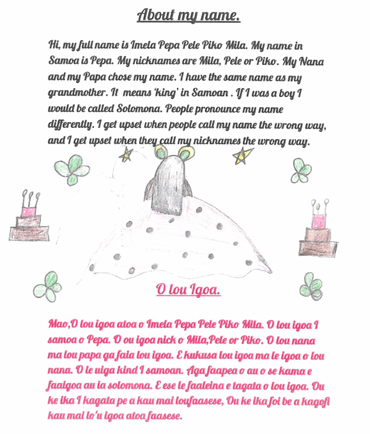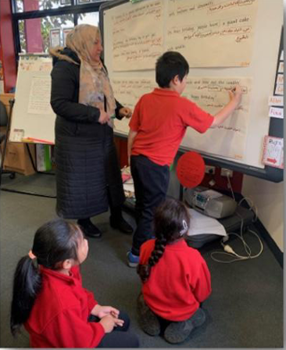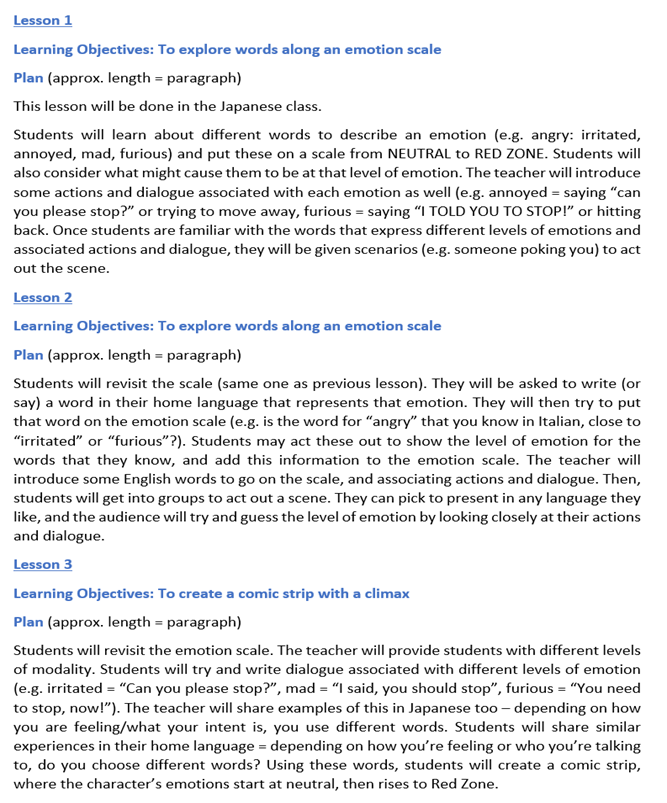The school community is an important source of support for plurilingual strategies because teachers may not share the home languages of their students. There are people in the school community who can help: parents, teaching aides and other teachers.
Students themselves can be the biggest source of support. Two central aspects of using plurilingual strategies are:
- showing an interest in students' linguistic knowledge and practices
- being prepared to learn about language alongside students
Teachers discuss getting support from the school community
Stories from the classroom
Working with parents
Teacher: Hien Webb, Collingwood English Language School
Class type: EAL students
Ages: 11 to 14 years old
Languages: Assyrian, Arabic, Samoan
EAL curriculum levels: B1 to B3
Hien designed an autobiographical project that would allow the parents to help their children with the content.
The students needed to write about themselves and their family: the story of their name, the languages they spoke, their journey to Australia, and hopes for the future. Hien encouraged use of home languages in the final product as well as throughout the learning journey. She enlisted a Multicultural Education Aide (MEA) to liaise with Arabic-speaking parents.
“We are very lucky to have the Arabic multicultural aide involved with us from the very beginning, from the translation of the letter to take home to the students and the parents, asking their permission to use photographs of the students when they were babies and young. Also asking the parents about what was it like when they were children […] and really involve the parents in the learning journey.”
The story of my name


This was a productive and fun way to receive support from parents, and to start to normalise the inclusion of other languages in the classroom.
The Samoan-speaking student benefited alongside the Assyrian and Arabic-speaking students because the parents were the main support for the activities. Connections were strengthened between home and school.
Student reflections
“I feel good when my family learn with me how to speak English. And I learn Samoan from them.”
“I learned new words in my language an[d] then I learn English.”
“I learn more Arabic. Because my mum know[s] what I learn at school.”
Weaving parents' background knowledge into initial plurilingual strategies helped to normalise home languages in the classroom and was very engaging for students. Learning English was the main focus, but the students were eager to learn more of their home language.
Further resources
Brochures and posters are available in different languages to promote the benefits of bilingualism and provide strategies for families to use their home language to support learning.
Working with education support staff
Teacher: Michelle Andrews, Preston North East Primary School
Class type: EAL students, withdrawal class
Ages: 9 to 11 years old
Languages: Tagalog, Somali, Mandarin, Telugu, Malayalam, Arabic, Vietnamese
EAL curriculum levels: B1 to B3
Michelle worked with small withdrawal groups of EAL students. She supported her students' learning by giving education support staff an active role in the classroom. She wrote a shared text on the whiteboard, and then invited a teaching assistant to her class. The teaching assistant then wrote underneath in a different language, and talked about similarities and differences between the two languages. She did this with Somali, Vietnamese and Arabic.
"It was a fabulous chance for teaching assistants to talk about how things work in different languages. For example, in the Somali language, you need a helper word with each of the verbs and even though it's not exactly the same helper word with each verb, the students got to recognise it. We'd say, "Where's the process in this sentence?" and they go, "There it is because that's the helper word."
The teaching assistants were very happy to be asked to provide this kind of support in the classroom, and the students who shared the home language were particularly excited. Parents could also be invited into the classroom to provide the same kind of support for their home language.
Excerpt from a school newsletter


Working with language teachers
Teacher: Nozomi Koyama, Huntingdale Primary School
Class type: Mainstream bilingual program – Japanese/English
Ages: Year 2
Languages: Japanese, Mandarin, Greek, Vietnamese, German
At Huntingdale Primary School, English is the instructional language 50% of the time and Japanese 50% of the time. Many students come from linguistically diverse backgrounds. More than 80% speak another language at home.
In this setting, Nozomi trialled different plurilingual strategies as a way to meet English curriculum objectives. Many of her students spoke different languages at home and were also proficient in English. During this process, she learned that students who were monolingual at home could become disengaged.
She decided to include the Japanese teacher so monolingual students could also access a different language in her lessons. The Japanese teacher taught the first lesson in the sequence, and students then had Japanese words that they could bring over into the English class.
"I think the best thing that I've done this time was to start my first lesson in Japanese. I handed my first lesson over to my Japanese counterpart. He taught an emotion scale. I showed the same emotional scale and with sticky notes the students wrote all these words they know to describe different emotions in different languages. We had Mandarin. We had Vietnamese. We had some Greek, German, a lot of Japanese words. So everyone felt like they could participate. The enthusiasm from students was fantastic."
Year 2 Lesson sequence – Word choice and emotions

Working with language teachers in mainstream schools can support inclusive plurilingual strategies. This is a way to promote the language taught at school and to promote bi/multilingualism to monolingual students.